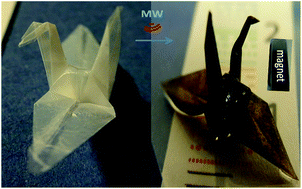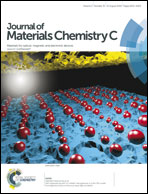Origami magnetic cellulose: controlled magnetic fraction and patterning of flexible bacterial cellulose†
Abstract
Cellulose of microbial origin is becoming a commodity structural material with promise in a myriad of potential applications. The range of applications can be further enlarged by nanocomposites that provide additional functional properties to the bacterial cellulose. Here, bacterial cellulose films nanocomposited with iron oxide nanoparticles are fabricated by microwave-assisted thermal decomposition within only 5 min and without the need for any post-synthetic treatment. The in situ synthesized nanoparticles are crystalline, less than 10 nm in size, and with a narrow particle-size distribution. Control over the magnetic fraction (from 4 to 40 wt%) is achieved either by employing undried cellulose, cellulose films dried by different methods, or by adjusting the initial iron precursor concentration. Structural, magnetic, and mechanical characterization of the materials is included. All films react easily to an external magnetic field, present a superparamagnetic behavior at room temperature, and are flexible enough to be bent and folded into complex origami shapes. Interestingly, films with low magnetic fraction are also transparent which is a highly attractive property for magnetic materials since most of them are either metallic or absorb visible light. Finally, preliminary results on a strategy to selectively pattern bacterial cellulose with nanoparticles are presented that pave the way to new uses of functional bacterial cellulose.


 Please wait while we load your content...
Please wait while we load your content...